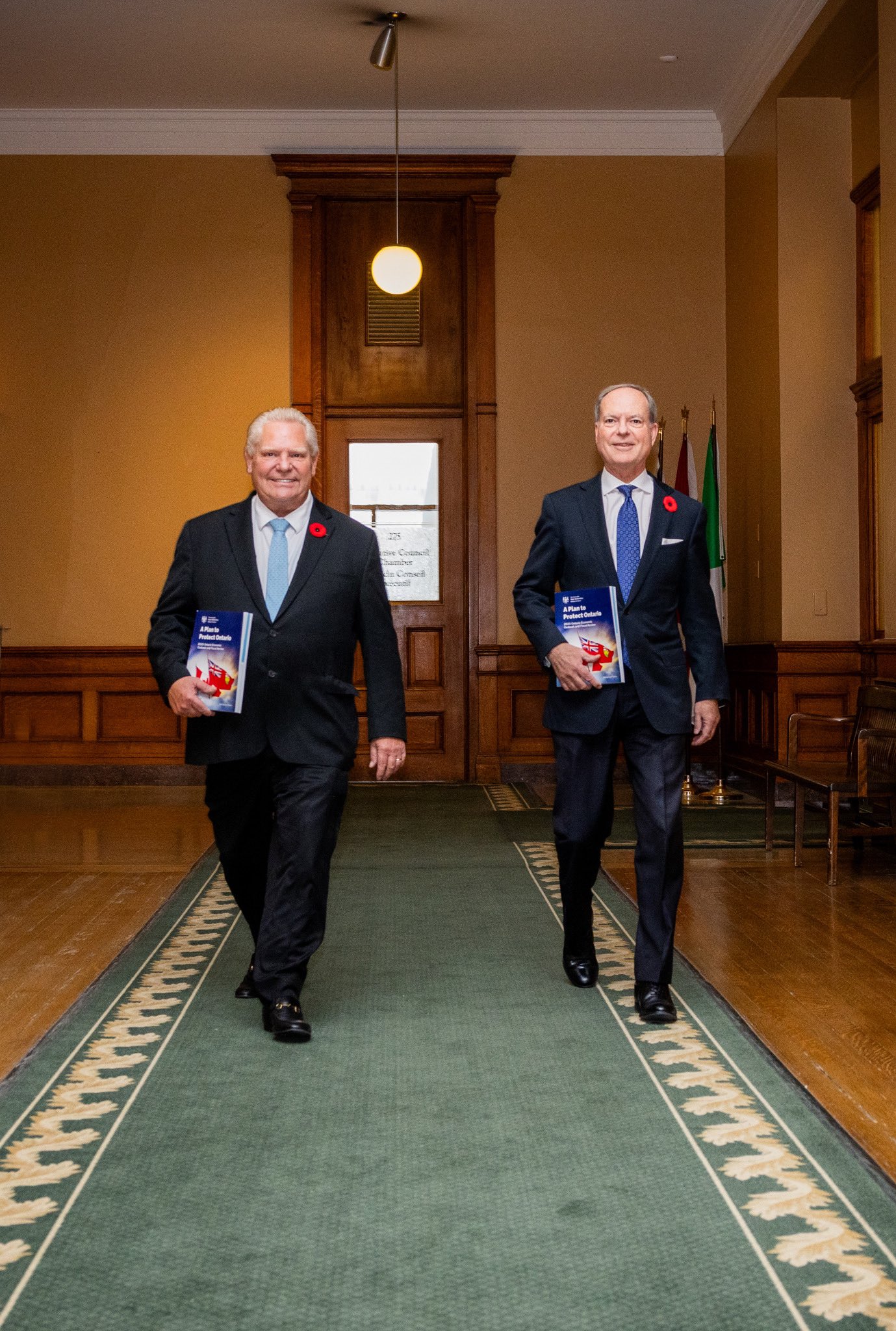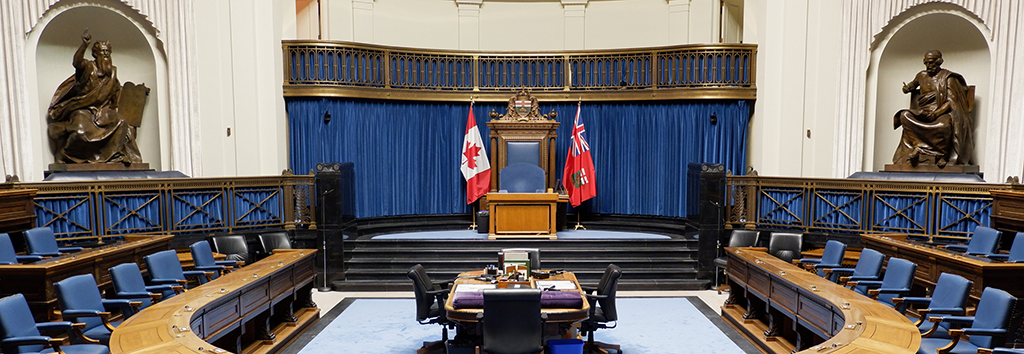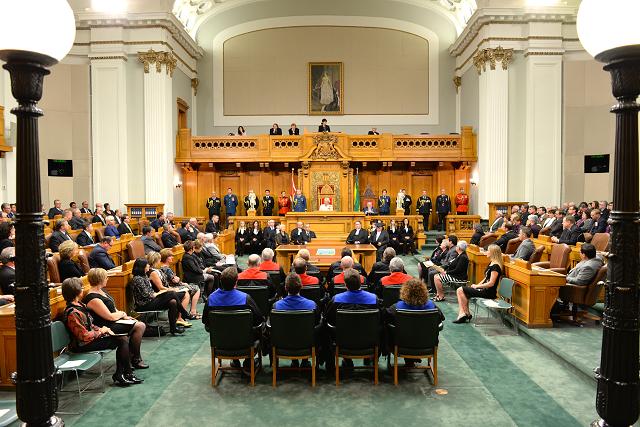The 2025 Ontario Economic Outlook and Fiscal Review, titled "A Plan to Protect Ontario," was tabled in the Ontario Legislature today amid escalating U.S. trade tensions under President Donald Trump, whose tariffs on steel, autos, aluminum, lumber, copper—and looming threats to semiconductors, minerals, and more—are directly targeting Canadian and Ontario workers. This optimistic yet cautious update contrasts with last year's more guarded outlook, emphasizing fiscal discipline and proactive support to navigate global uncertainties like the ongoing U.S. trade dispute, next fall’s US midterm elections, and international conflicts.
Fiscal headlines show continued progress with the 2025-26 deficit now pegged at $13.5 billion (1% of GDP, versus the federal 2.5%), tracking for a $7.8 billion deficit in 2026-27 narrowing to a $0.2 billion surplus by 2027-28. This would keep Ontario as the only large province on track for balance. Interest costs remain low at 6% of revenues (near 40-year lows, far below the federal 13%+), backed by two fresh credit rating upgrades and eight straight clean audits from the Auditor General.
Some of the key highlights of today’s fiscal update, including announcements previously made by the province, include:
- HST Rebate for First-Time Home Buyers: Rebates full 8% provincial HST on new homes up to $1M, saving up to $80,000 (combined with federal relief, pending passage)—subject to federal alignment.
- Tax Action Plan: Updates personal/corporate income taxes to attract investment, boost G7 competitiveness, and cut costs for families/businesses; full details in 2026 Budget.
- Enhanced Ontario Made Manufacturing Investment Tax Credit (OMMITC): Temporarily raises rate to 15% from 10%; extends non-refundable version to non-CCPCs; broadens machinery/equipment eligibility for cost savings and innovation.
- Buy Ontario Procurement: Shifts $30B annual spend to prioritize local goods/services, strengthening supply chains and investment.
- Indigenous Opportunities Financing Program (IOFP): Expands via $3B Building Ontario Fund loan guarantees to boost Indigenous economic participation across sectors.
- Free Trade Within Canada Act, 2025: Reduces interprovincial barriers to enhance trade/labour mobility and economic integration.
- Ontario Together Trade Fund (OTTF) Boost: Adds $100M (total $150M over 3 years from 2025–26) to help SMEs diversify markets and build tariff resilience.
- Red Tape Reduction: Protect Ontario by Cutting Red Tape Act, 2025 (50+ changes for efficiency/cost control); Building a More Competitive Economy Act, 2025 (streamlines permits/labour mobility)—aiming for top G7 business climate.
- $2.1B Primary Care Action Plan: $235M in 2025–26 for 130+ teams; $300M over 4 years for 17 teaching clinics; $250M+ for 75 more teams—ensuring province-wide access.
- Home Care & Hospital-to-Home (H2H) Expansion: $1.1B over 3 years ($982M for home services; $170M+ for H2H) to relieve hospital pressures and deliver care in communities.
- $56B Health Infrastructure Plan: Funds 50+ hospital projects and ~3,000 new beds over 10 years for accessible, people-centered care.
- Record $201B Capital Plan: $33B in 2025–26 to sustain jobs amid tariffs; addresses economic uncertainty.
- Municipal Supports: $1.6B Municipal Housing Infrastructure Program (MHIP) to accelerate homes/infrastructure; $100M OMPF increase over 2 years for essential services.
Upstream's Analysis
Very much like the 2025 Progressive Conservative election campaign platform, today's focus was dominated on measures to protect Ontario’s economy in the face of the US trade war and measures to build a self-reliant economy that is the most competitive jurisdiction in the G7. With that in mind there was a major focus on manufacturing, energy, and natural resources, all of longstanding importance to this government.
Although there was less pomp and ceremony in this year's FES than previous iterations, it is still the hallmark omnibus government legislation for the fall legislative session and tackles many long standing goals of the third term Ford government, including affordability matters, housing starts, continued investments in health care, and continuing to cut red tape.
The Minister took time to tout the government's prudent fiscal management, credit rating upgrade, and the fact that they have never raised a tax under Premier Ford’s leadership, all important issues to the governing party’s base.
The Government’s focus on tariffs, protecting jobs and the economy will remain Premier Ford’s top priority while the Federal Government continues to attempt to negotiate a trade agreement with the United States. Premier Ford has enjoyed taking the mantle of Captain Canada, and politically it continues to work for him, as seen in the public response to the Premier’s “Reagan” ad.
While Minister Bethlenfalvy and the government are showcasing a cautious optimism in the face of tariffs and global economic uncertainty, tariffs continue to loom large in their political calculations. As you formulate your approach to appealing to the Ford government, how your sector or organization is being impacted by, or responding to tariffs will remain an important consideration for the foreseeable future.
Ready to ShaAs Minister of Finance Peter Bethlenfalvy noted in tabling his annual Fall Economic Statement (FES), "Now, with our finances in the best shape they’ve been in over a decade, we are in a strong position to act for Ontario, but we know the road ahead is not without challenges. As a province and a country, we find ourselves in the midst of trade uncertainty that we did not ask to be a part of, causing anxiety for workers and businesses alike.” Narrative?
Consultations for the 2025 Ontario Budget are now open. Upstream stands ready to help craft your pre-budget submission and provide strategic advice on how to best position your organization for the year ahead. Please click here to set up a consultation.








